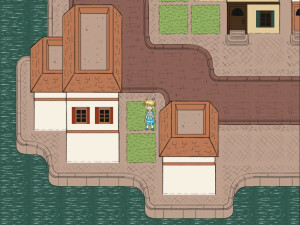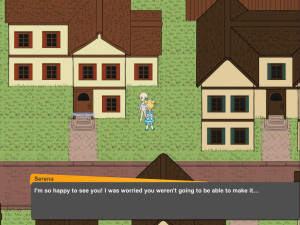
I’ve been hinting for awhile now that I’ve been working on a new game. I’m finally going to drop a few details as to what it’s actually about. Keep in mind that this project is still VERY early in development, so a lot of things will change along the way. Especially the horrible placeholder art.
Decisions, decisions…
After finishing Swift, I experimented with a lot of different ideas for Phanatix’s second game. However, most of what I was coming up with wasn’t really interesting to anyone. Including myself. I was too busy keeping up with the latest trends in the gaming world (social media integration, microtransactions, A/B testing, etc.) to pay attention to what I really wanted. That was a mistake. I needed to come up with something that would stand out in the crowd– something that I could be passionate about.
I had one design doc that I just couldn’t put down. But it was a fairly large game. One far too ambitious for a lone developer going solo to complete successfully. Or was it, I wondered… I researched various game engines to find out if making such a big game by myself was possible. Using what I had learned, I started putting together a tech demo. Amazingly, I managed to complete the basic functionality in a mere three weeks. That was the confidence boost I needed. It was time to get serious. After years of self doubt, there was no room for fear of failure anymore.
What am I making?
I wanted to make something unique. Something that was all my own, a game no one else on this earth could possibly create. To accomplish this, I looked to my own life experiences for inspiration. It would be pretty hard to make a shovelware clone out of an individual’s interpretation of real life.
Whenever I start thinking up games I’d actually like to play for fun (instead of market research), they usually form in a particular genre. I grew up playing Japanese role-playing games more than anything else, so it only makes sense that I naturally gravitate towards them in my own designs. The problem is that JRPGs require a lot of content and a lot of testing. In other words, they’re difficult to make by yourself. But there comes a time when you have to throw caution to the wind and just do what you need to do. And this is one of those times.Just to be clear, when I say “JRPG” I mean a narrative focused game with a linear story and a set of predefined characters whose gameplay contains world exploration, item collecting, character stats, and usually a turn-based combat system of some sort. I am well aware that this interpretation changes from person to person, but I figured calling it a JRPG would be easier to understand than, “a western game done in the style of a traditional Japanese RPG.” That’s kind of a mouthful.
The only reason I got into game development in the first place was so that I could one day make JRPGs. When I was a kid, I dreamed of working for (what was then) Squaresoft at their office in Japan. But I got sidetracked along the way, and it didn’t really help to hear things like, “You’re not supposed to make games like that, you’re not Japanese,” or “But you don’t live in Japan, you can’t make that kind of game.” However, these arguments are about as silly as “You can’t make games because you’re a girl.” People can be real jerks, but that shouldn’t stop anyone from pursuing their goals.
What’s the game about?
The game follows the story of a young girl named Serena whose life is turned upside down overnight by forces she cannot understand. All that matters is surviving her sentence of solitary imprisonment by whatever means necessary. However, things are not quite as they seem– the line between fact and fantasy is a blurry one. This isn’t a game about saving the world, but rather about saving yourself in a world where you are powerless. With the help of some mysterious new friends, Serena learns to summon strength from within to stay alive.
The story starts out fairly benign, but Serena’s world takes a turn for the dark and twisted as things progress. It covers Serena’s adventures over a few years’ time, and she grows into a very different person by the end of her tale. The game will be divided up into chapters that will released in an episodic fashion as they are completed. The prologue chapter (the one I’m working on now) is about Serena’s blissfully naive life leading up to the disaster that will forever change her existence.
As far as gameplay is concerned, there will be an active turn-based combat system, story-centric minigames, item hunting quests, a variety of levels to explore, and the occasional cinematic cutscene. Basically, it has all of the ingredients that should appear in any good JRPG. Oh, and it’s all going to be done in anime style sprites. Icing on the cake!
Why am I making this?
I’m making a game about being powerless in a world that betrays you because that’s exactly how I feel right now. I’m tired, depressed, and above all else bitter and angry. We live in a society where we’re told that hard work will lead to success, but I’ve been working my butt off for years only to get nowhere. Between crushing student loan debt and a flooded job market, it’s been nearly impossible for me to make a living in recent times. And I’m not alone, this story is unfolding all over the place. This project has been a sort of anger management tool for me– a place to vent my frustrations and tell the world how I feel. It seems to be working, as I’ve been much happier since I started working on it.
How am I building this?
The engine I settled on is the ever popular Unity 3D engine. Being a sprite based game, I’m using Unity’s 2D setup to get the look and feel that I want. What really sealed the deal on Unity was all the third party support from its Asset Store. Being a solo dev, it’s important to work smarter, not harder– there’s no reason why I should reinvent the wheel when I can buy most of the scripts I need. So far, I have a working prototype and haven’t actually coded anything. I’ll probably have to make some custom scripts once I get into the more complicated stuff, but buying premade chunks of game functionality has been a huge time saver.For the curious, I’ll give a rundown of what Asset Store goodies my game is currently sporting. At the center of it all, I’ve got Hutong Games’ Playmaker handling the game logic. It’s a pretty handy visual scripting interface for those of us who would prefer not to program things. Next, no RPG is complete without a good way to handle loads of character conversations, so that functionality is handed off to Pixel Crushers’ Dialogue System for Unity. Finally, I needed a good way to dish out tile maps for the level art. For that, I’m using Rotorz Tile System, which makes it easy to “paint” tiles over a grid to create levels.
All of these guys work together with Playmaker inside of Unity so I can access their properties and functions whenever I need them. In short, this means I can focus on content creation instead of nitpicking technical details.
How far along is the game?
As I mentioned earlier, this game is still very early in development. All of the art is still placeholder, as you can tell from the ugly screenshots with debug info plastered everywhere. The non-playable characters are still bald/naked because I haven’t done their individual spritesheets yet. It may not be pretty, but there’s a lot of functionality in here: the player/camera movement is working, level tilemaps are laid out with collision detection, there’s scene loading with saved data, and there’s twenty five pages worth of dialogue events sequenced. You can play through all the events from the beginning of the chapter until the end of it, minus one optional minigame I have yet to build. It almost feels like a game. Almost.
Since the game is episodic in nature, I’m approaching each chapter separately. I’m still working on the very first prologue chapter, which has one out of four development iterations completed. That’s not counting the other eight chapters that come after this one. I’ve been working on the prologue since August of 2014; it’s coming along, but a lot of what I’m doing at this point is research and experimentation. Getting the first part done is going to take the longest, but hopefully things will go quickly once the foundation is built.And let’s not forget that this doesn’t include marketing materials (promotional websites, video trailers, etc.) that will need to be created along the way, which is going to add a considerable amount of time to production. Necessary evils, they are.
Why am I showing this so early?
Let’s be honest here, how often do you get to see games take their first baby steps? Almost never. You usually see them roll out to the public when they’re in either alpha or beta phases, when they’ve got most of their features and assets already done. I thought it would be cool to show this game as I work on it over time. This way you get to see it evolve from nothing into a full fledged game worthy of your time and attention. Right now it looks like total crap, but that’s how all games start.
When is it coming out?
The short answer is… not anytime soon! The game’s prologue chapter won’t be ready to launch for at least another year. And that doesn’t include the rest of the game that comes after that. At this point, it doesn’t even have a title yet, let alone a website or anything to promote it. Needless to say, I’m going to be working on this for a long, long time. But that’s ok. In the end, it will be worth it to create an experience I will genuinely love to play.





Leave a Reply